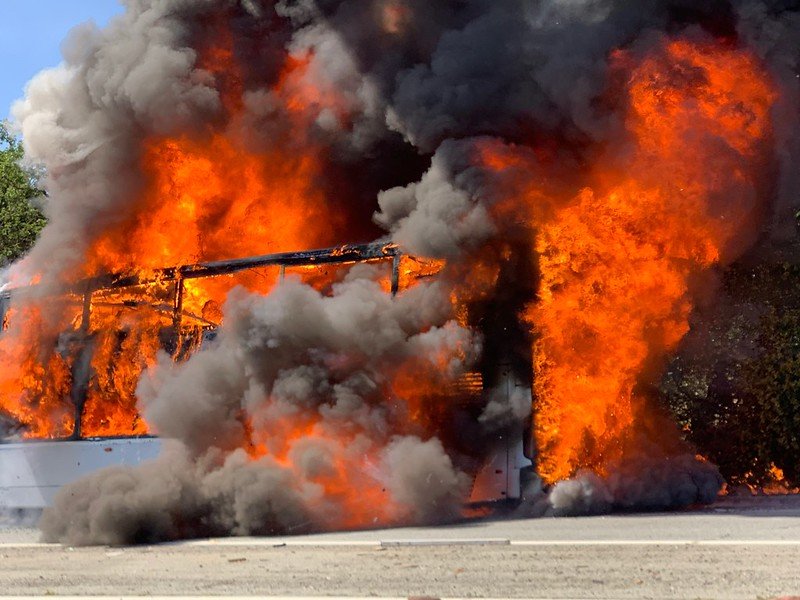On 11 October, criminals carried out a series of attacks in Vitória Metropolitan region. The action would be a retaliation for the death of an alleged gang member, which occurred during a shooting with the Military Police the night before. Amidst the acts of violence, buses were gunned and torched. Schools, and other public and private institutions were closed. One child was injured in the head by a stray bullet.
These incidents reflect the development of drug gangs in Espírito Santo, particularly in the Metropolitan Region, where several territorial disputes have been reported lately. The wave of attacks only reinforces the idea that the organized crime in ES has been following the steps of violent factions from Rio de Janeiro, such as the Red Command (CV), due to similar local circumstances and constant exchange.
OCTOBER’S WAVE OF ATTACKS
The multiple acts of violence in Vitória began on Tuesday (11/10) morning and continued until the night. They would have been motivated by the death of 26-year-old Jhonatan Cândido, who was killed during a shooting in Bonfim neighborhood, Northeast of the city. According to the police, Jhonatan was a security guard for drug trafficker Fernando Moraes Pereira Pimenta, known as ‘Marujo’, who is the in loco leader of the First Vitória Command (Primeiro Comando de Vitória – PCV), a gang responsible for the drug trafficking business in several regions of Espírito Santo (ES). Marujo was the target of the operation, but he managed to escape.
The incident led to a wave of retaliatory actions, which began on the same day, at 10h30, in Consolação neighborhood, where Jhonatan was killed. In the first action, armed men surrounded a bus, forced it to stop, removed everyone from inside and shot the vehicle several times. A bit later, and a few kilometers away, reporters from a news channel were forced out of their vehicle, the cameraman was beaten, and the car was shot and torched in the vicinity, in Penha neighborhood.
In the afternoon, three more buses were torched, one more in Consolação, one in Santo Antônio, West of the city, and another in Vitória Central area.
The three final attacks took place at night. The first in Enseada do Suá, near Papa Square. The second in Santa Helena, near the Third bridge. The last incident occurred in Contorno Ave, outside Vitória.
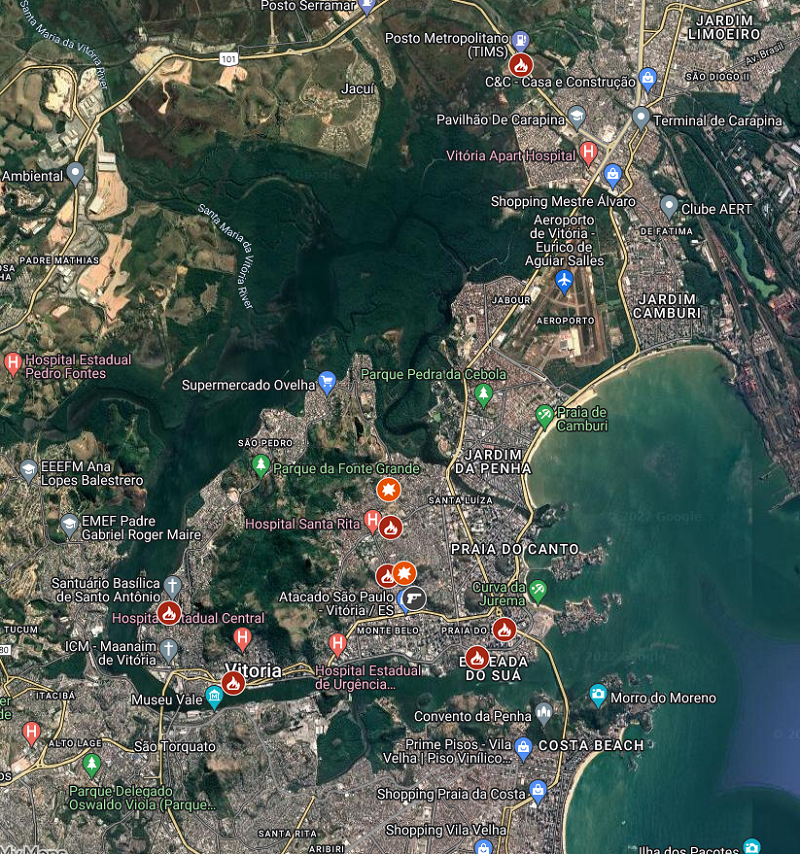
During the turmoil that ensued after the death of the alleged drug trafficker, in addition to the cases of vandalism, there was also a case of stray bullet. A 10-year-old boy that was playing inside a school was shot in the head. The misfortune took place close to Bonfim, in the São Cristóvão neighborhood. Media sources revealed that the school where the boy was shot is close to Morro do Macaco, Tabuazeiro, which is dominated by the criminal faction Vitória First Command (PCV). In a straight line, the school is about 1 Km from the Penha Complex, a conglomerate of favelas, which is also PVC’s headquarters. When the kid was shot, criminals would be shooting at police forces from Macaco favela, while other criminals were attacking the vehicles.
When the first news about the wave of violence hit the headlines, fear spread across the capital of Espírito Santo and, stores and several public and private institutions decided to stop their activities. The Federal University of Espírito Santo (Ufes) suspended classes and students, staff, and professors left Maruípe and Goiabeiras campuses.
The City of Vitória informed that it suspended classes in the afternoon shift in three schools of the city public education network due to the attacks. The schools closed are located in Consolação and Bonfim neighborhoods, near the location of the first attacks. The city administration also suspended service in three health units, in Consolação, Bonfim and Penha neighborhoods. Finally, the public transport was jeopardized too. According to the Urban Transport Company of Greater Vitória (Ceturb), at least eight bus lines were suspended, and two others had their itinerary changed to avoid critical zones.
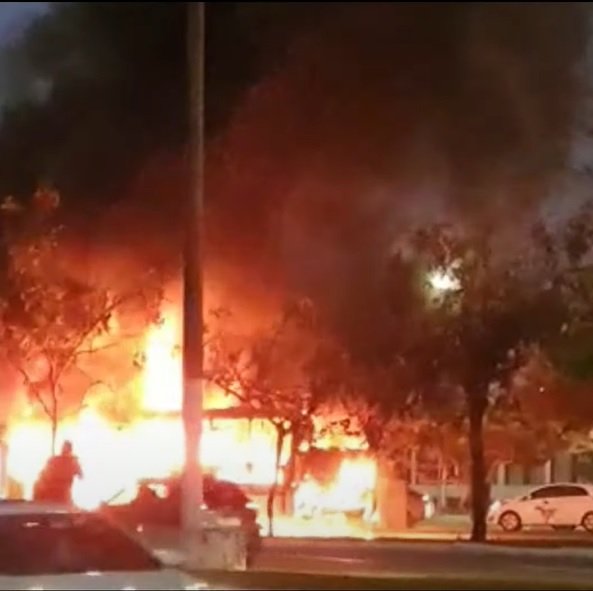
FEAR AND CHAOS: A STRATEGY TO BARGAIN WITH AUTHORITIES
The episodes of chaos that took place in Vitória metropolitan area is not a novelty in Brazil. In fact, it is a traditional tactic among the oldest gangs, such as the Red Command (CV) and the First Capital Command (PCC). In addition, as these two gangs expand to other regions of Brazil, they teach or influence new factions, like PCV, their strategies.
Criminals promote these waves of organized and concerted attacks as a strategy of retaliation. They seek to spread an idea of chaos and insecurity to instill fear in the local population, at the same time, demoralizing security forces and politicians, particularly the local executive, which is responsible for the public security. It is a way to show force, create pressure and try to bargain with authorities.
There is a long list of similar incidents that took place in other Brazilian states throughout the last decades. Below, some of the most iconic are highlighted.
São Paulo – From 12 to 21 May 2006, the most famous wave of attacks took place. Criminal and aggressive actions targeting security forces and some civilians (car, buses, buildings, police stations etc.) were carried out mainly in São Paulo state by the First Capital Command (PCC). In addition, there were rebellions in 73 penitentiaries in the state. The day before the attacks, the São Paulo State Penitentiary Administration Department had decided to transfer 765 prisoners to Presidente Venceslau Penitentiary 2, a maximum-security unit located in São Paulo countryside, after wiretaps revealed that criminal factions were planning rebellions. Among the prisoners to be transferred was Marcos Willians Herbas Camacho, known as “Marcola”, considered the leader of the PCC. According to data from the Laboratory for the Analysis of Violence at the Federal University of Rio de Janeiro (UFRJ), 564 people were shot and killed and 110 people were injured by firearms during the turmoil, including 59 public servants (policemen, penitentiary agents, and firemen). The attacks led to a response by outlaw “vigilante groups”, mostly composed by policemen, which, executed around 122 people, according to UFRJ’s Lab. The violence came to an end after an alleged meeting between the then Governor Claudio Lembo and Marcola, which would have sealed an agreement.
Rio de Janeiro – In December 2006, attacks promoted by Rio drug gangs led to the death of 18 people. Vehicles were set on fire and shot; police stations and cabins were machine-gunned. The terror acts would have been a response to the isolation of some gangs’ leaders that were in jail and the advance of militias, associated to the security forces, in territories previously controlled by the drug trafficking gangs.
In May 2017, nine buses and two trucks were set on fire by criminals, after a mega-operation by the Military Police to end the war between drug dealers in Cidade Alta, a community in Cordovil, in the North Zone. The operation arrested 45 suspects, killed 2, and seized 32 automatic rifles.
Santa Catarina – From 11 to 18 November 2012, 58 incidents took place, targeting buses, military and civil police bases and private vehicles. The event affected 16 cities, mainly the capital, Florianópolis. They would have been motivated by the mistreatment of prisoners, overcrowding and the insufficient number of doctors in the penitentiaries. The attacks ceased by order of the bandits themselves.
From January to February 2013, a new wave appeared. 111 attacks happened. This time, 36 cities were hit by the violence. Perpetrators were driven by the transfer of prisoners and the crackdown on drug trafficking.
Ceará –January and February 2019, gangs promoted 283 attacks in 56 cities, 3 suspects were killed, and 4 people were injured. The action was a retaliation for changes in the state’s penitentiary system, which were promoted by Penitentiary Administration, which announced the non-recognition of factions, stricter rules in prison and the end of the segregation of prisoners according to their gang affiliation. The National Force had to be mobilized to contain the criminals.
In September 2019, Guardians of the State (GDE), a local gang, promoted 95 attacks in at least 16 cities, during eight days of attacks. Businesses, cars, motorcycles, private trucks, the parking lot of the Castelão – the Fortaleza football stadium – and even a church were targeted. To halt the attacks, authorities transferred Ednal Braz da Silva, head of GDE, to a federal prison.
Amazonas – From 6 to 8 June 2021, the local Red Command (CV) torched buses and private and police cars, explosives were also thrown at public buildings, such as bank branches, and bus stations. The gang acted in response to the death of a drug trafficker in a police action on 5 June. Besides the capital, Manaus, nine cities in the countryside were engulfed by the wave as well. Many public services were suspended: the Covid-19 vaccination, health care, transport, and classes. The National Force was sent to stop violence.
THE RECENT GANG WARS
Besides the wave of attacks seen on 11 October, gangs operating in Espírito Santo have been quite active and showing force through a series of wars for territory. In March, reports with data from January and February showed that a gang war in Vila Velha led to a 156% increase in homicides in the city, when compared to the same period from 2021. The results went on the opposite way when compared to the trend observed in the state. Except for Vitória Metropolitan Region, which had a 6% increase in homicides, all the remaining regions presented expressive drops, some reaching a 72% reduction, which was the case of the South Region.
The fight in Vila Velha started with the attempt of a gang leader to recover lost territories after a period of absence. In June 2021, Luan Resende Buarque had been arrested in Méier, Rio de Janeiro (RJ) North Zone, while seeking help at a hospital to treat a Covid-19 infection. Until then, he had been hiding himself in Complexo da Maré, a set of favelas disputed between the Pure Third Command (TCP) and the CV. In December, when he was released from jail, Luan, who controlled the drug trade in Ibes neighborhood, in Vila Velha, went after his rivals in Santa Monica and Santa Rita neighborhoods to reconquer the lost space. Other locations in this city where fights have been reported are Primeiro de Maio, and Ilha da Conceição.
Vila Velha is not the only region where conflicts and assassinations have been witnessed in the last months. News from local newspapers reveal continuing conflicts in Vitória, Cariacica and Serra too. For instance, from 17 to 19 June this year, the Vitória central area had several shootouts inside four gang-controlled favelas: Piedade, Alagoano, Moscoso and Cabral, some of them lasted at least three hours.
The Morro do Cruzamento is another neighborhood in the capital that is constantly under attack. Moreover, in one of the shootouts, on 1 August, which lasted from midnight to 2:00, an innocent couple was hit by several shots fired by the criminals at war. They were caught in the crossfire while in their car and died.
In an article from A Gazeta, the Espírito Santo Military Police General Commander, Colonel Douglas Caus, told journalists that the increase in the number of armed attacks and shootings recently registered is due to the clash between the major gangs in ES, the oldest and most powerful, the PCV, and the Capixaba Family Association (AFC).
The General Commander also explained that, being a relatively new criminal organization, with around 3 to 4 years of existence, the ACF is undergoing a process of expansion. Meanwhile, the PCV, a much older gang, founded in 2010, seeks to keep the ACF away from its territories and conquer new ones.
To make matters worse, the two factions mentioned above are not alone, they share space with the famous PCC and the TCP. According to an interview given by Civil Police Chief Romualdo Gianordoli, head of the Specialized Department of Homicide and Protection of Persons (DEHPP), to radio CBN, the PCC, being a large faction, does not seek the control of drug houses – drug sales points. Its priority is to expand its international business and do large scale sales through the port, avoiding bloody conflicts on the streets. However, the TCP, from Rio, and the AFC would be allies, which brings more manpower to the fights against the PCV.
A CHANGE IN SCENARIO
According to Gianordoli, the crime scenario in ES has changed for the last 11 years. Before, there were many drug houses scattered and independent, which occasionally fought between themselves, but with very little destructive potential, mainly because the small groups generated small sales, and consequently little money to acquire heavy weapons and other resources.
The emergence of PCV as an organized group matches Gianordoli evaluation about the changes in ES crime landscape. The group appeared around 12 years ago, after its current leader and founder Carlos Alberto Furtado da Silva, alias Beto, had contact with the PCC, while serving time in a federal prison. Beto was inspired by that group’s structure and even used the statute of the gang from São Paulo to create PCV’s own version of the document.
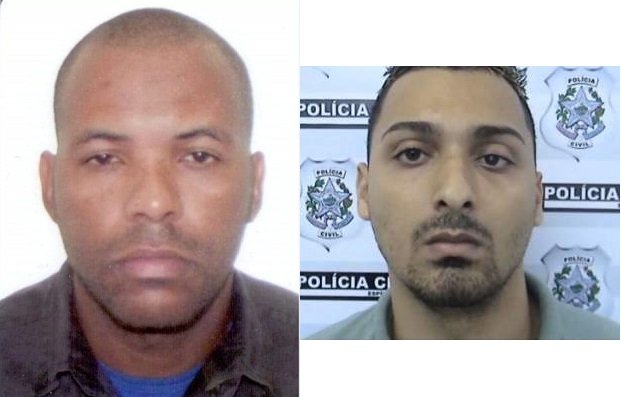
Being the biggest and the most organized, PCV became the strongest group in ES, especially by 2013. Therefore, it advanced over the smaller gangs that controlled one or a few drug houses. The AFC emerged as a response to this, as a way for these smaller groups to defend themselves, according to Gianordoli.
General Commander Caus states that, for a period, the two organizations had well-defined areas without many clashes. However, with the constant territorial expansion and the proximity between regions dominated by each faction, the fights intensified.
The main motivation for the attacks, as Caus pointed out, is the conquest of new drug sales points. New territories annexed mean more locations for selling drugs and, consequently, faction enrichment, which provides more capacity to buy heavy weapons and equipment – automatic rifles, grenades, bullet proof vests, specialized ammunition, machine guns, sniper rifles, drones etc. – necessary to defend themselves and conquer new “markets”. It also enlarges the population under their influence, increasing chances of enlisting more soldiers to their ranks.
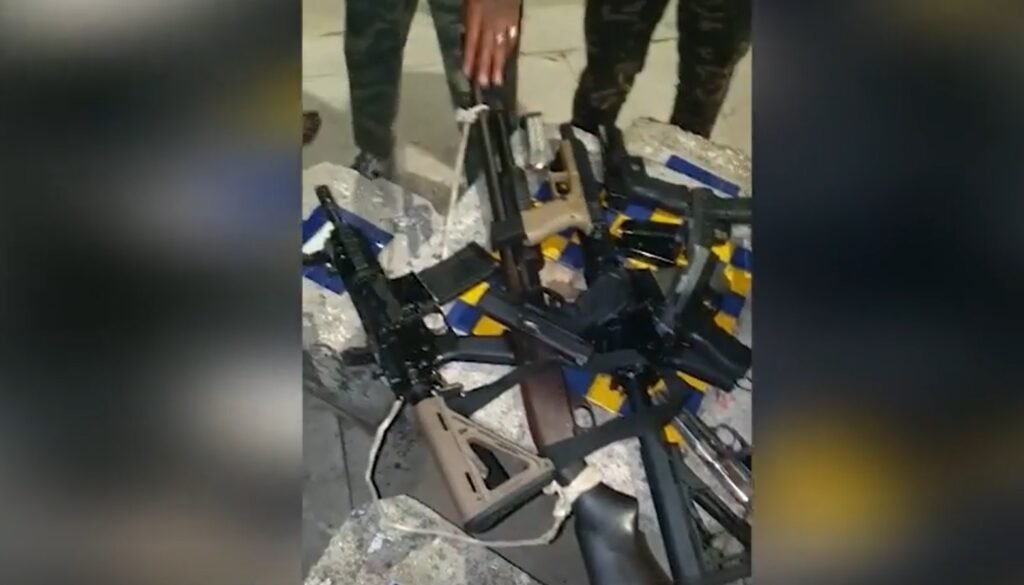
The scale of this expansion process is now revealed by the number of territories under the gangs’ control. According to a police report published on the Tribuna Online, only in Greater Vitória, 129 neighborhoods spread across five cities – Vitória, Vila Velha, Cariacica, Serra, and Guarapari – already have the presence of these criminal groups, while other places maintain small independent drug sellers that can soon become part of the factions, either by force or agreement. Moreover, police sources state that the drug trafficking factions are not limited to the metropolitan region, they are present in the entire state.
FOLLOWING RIO’S PATH TO VIOLENCE
The scenario observed in Espírito Santo, particularly, in the metropolitan area, bears many similarities with that of Rio de Janeiro, when drug trafficking started to grow in level of violence and evolved towards what it has become today. This fact sounds an alarm about the risks of a further escalation in gang violence in ES.
The presence of more than one faction is one of these similarities. In Rio, from a certain point, the CV split into the Third Command (TC), which later split again to become the TCP. A few years ahead, the Friends of Friends (ADA) was founded in a similar way. The presence of many powerful enemy groups leads to an arms race and a rise in violence. According to reserve colonel of the Military Police of Rio de Janeiro and SBM’s security manager, Henrique Lima de Castro Saraiva, people believe that the drug trafficking gangs started to acquire automatic rifles, machine guns, grenades to fight the police. However, he explains that this is a misconception, he states that the police just followed this trend to fight back the criminals, who had initially started to buy heavy weapons to defend themselves and conquer new territories.
Another point to be taken into consideration is the topography of the area. It is common knowledge that the urban characteristics of Rio’s poor neighborhoods is an additional impediment to police work and the fight against armed trafficking. Heavily armed criminals can see the police arriving, shoot at them and hide more easily. Like Rio, Vitória metropolitan area is located between hills, the sea and has a bay in the middle. People delt with these challenges to urban growth by building in the hills. Now, the greater Vitória has several large poor communities over steep hills with very narrow alleyways, providing a favorable condition for the PCV, the AFC, and the TCP to replicate what is seen in Rio.

After the wave of attacks promoted in Vitória in the beginning of October, PCV’s in loco leader, Marujo is said to have escaped to Rio de Janeiro, and remains hidden there. Intelligence reports from the security forces indicate that this collaboration between criminals from ES and RJ is becoming common and reveals a strong alliance between them. These ties do not stop here, they go beyond. Gangs from Rio are also drugs and arms suppliers to the criminals in ES.
Such close contact may create an ideal environment for the learning of advanced techniques in the fight against the security forces and rivals as well, like the wave of attacks promoted in the beginning of October. This means that the gangs in ES can learn to respond to challenges the same way Rio’s factions did, with extreme violence. Instead of avoiding conflict, like PCC in São Paulo, they may become more and more belligerent. One may also conclude that the fact that two rival groups from Rio are present directly and indirectly in ES, can transfer the existing rivalry to another state. Currently, the TCP is directly established in ES and the CV supports the PCV.
For instance, like the factions in Rio de Janeiro, those operating in Espírito Santo have already developed tactics of resistance to the actions of the police and their opponents. When a police operation provokes a financial loss to them, they resort to robberies and thefts, mainly cell phones. Therefore, security sources state that, an increase in the number of property crimes is normally recorded through crime reports after a police operation.
The gangs in ES have also been working with the beverage distribution sector, which helps them with money laundering. Such refined method may also have been taught and improved through contact with Rio de Janeiro groups, who have practiced them for a long time.
STILL A DISTANT REALITY
According to Douglas Caus, despite the incidents in October, the growing territorial disputes, the arrival and influence of factions from Rio, and the expansion of local gangs, the situation in Greater Vitória is still distant from that of its neighbor. For him, in RJ, criminals have a greater domain over the territories, which is why the police faces greater difficulty in accessing areas of conflict. On the other hand, he states that, in ES, the police is able to enter areas dominated by criminal factions and occupies these places without special support.
Police Chief Gianordoli also believes that, now, the reality of Espírito Santo is very far from that of Rio de Janeiro. According to him, the authorities would have to commit many mistakes in the management of public security for more than 10 years for ES to reach the point in which RJ is right now. He also mentions the fact that, in ES, the police can access any favela, despite, confrontations. Meanwhile, in the neighboring state, he claims that there is a de facto parallel power.
However, for Gianordoli, even though the level of violence in both states is not the same, he acknowledges that fighting the factions has now become the priority for public security in ES. He also says that the police has been trying to be attentive to the changes in crime and follow the evolution of this world to better fight it.
According to the specialists, for the ES not to end up reaching the level of violence and power of organized crime that exist in Rio, it is necessary to overcome the conditions in which criminal groups thrive. The problem affecting the communities is structural. Gangs take advantage of the vulnerable situation in which many families live to find new members and establish themselves. In this regard, projects, such as the “Estado Presente” – security project whose objective is to contribute to the reduction of violent crimes through social inclusion and other methods –, are the type of initiative that have a global focus in strengthening the primary defense mechanisms against the drug trafficking, which are family, school, among others. But there must also be a direct action from the police itself and investment in tools, intelligence, in personnel in order to carry out more and better operations to fight the criminal gangs.



